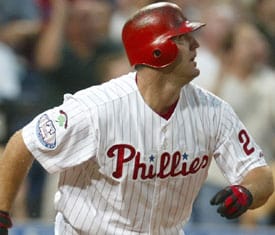

Thome immediately proved his value upon coming to Philadelphia, hitting a league-leading 47 home runs with a .266/.385/.573 line in 2003. The next season, opening Citizens Bank Park, he hit 42 home runs with a .274/.396/.581 line. Injuries derailed him in 2015, and the undeniable rise of Ryan Howard pushed Thome further removed him from the Phils’ future. He was traded to the Chicago White Sox in November 2005, bringing the Phillies prospects Daniel Hagwood and Gio Gonzalez, and starter Aaron Rowand.
Thome’s arrival in Philadelphia was a turning point in Phillies history. Before him the Phils’ front office didn’t sign big-ticket free agents, partly because the team wasn’t in position to do so, partly because ownership didn’t spend a ton of money. In 2000 the Phillies had the ninth-lowest payroll in baseball, but they entered the 2003 season with the 13th-highest payroll. They’d raise it even more for 2004 to have the fifth-highest payroll in the game.
The 2017 season marked the first time since 2003 that the payroll didn’t open in the top-13, with the Phils finishing in 22nd out of 30 major league teams with $116 million locked up.
This year? Before pre-arb and tendered contracts are signed, the Phils have only $6.35 million on the books. That’s ridiculous, and it’s dead last in baseball, a good $10 million behind the White Sox. After pre-arb contracts are settled and tendered players get theirs, the Phils will still have a minuscule payroll, somewhere around $40 million.
So the Phillies will spend this offseason. There’s no way they won’t.
The 2002 offseason, in which the Phils made that blockbuster Thome move, provides an interesting comparison for this offseason, which could bring some fireworks … or might not.
The 2002 Phillies finished 80-82 with a pretty similar Pythagorean record. They were 21 games behind a still very stacked Atlanta team, and in the one wild card era, were 15 games behind wild card winner San Francisco. They also looked up at Los Angeles, Houston and Montreal, plus division winners St. Louis and Arizona.
Offensively they had a few noticeable holes. They needed a second or third baseman, as Marlon Anderson didn’t turn into a stud and became a free agent (Placido Polanco was inked for the other spot). Doug Glanville had a poor 2002, but the Phils hoped Marlon Byrd would be able to take over center field as a rookie in 2003. The biggest hole, however, was at first base, where Travis Lee provided a subpar stick (though a great glove). Basically the Phils lacked one more big bat to help Bobby Abreu and Pat Burrell.
But pitching was as big an issue. The Phils banked on a young staff led by Randy Wolf, Brett Myers and Vicente Padilla, but nobody else had surfaced as a solid option. Brandon Duckworth was an unknown, Dave Coggin couldn’t keep guys off base, and Joe Roa was nothing more than a long man. The bullpen was all over the place, with veterans Jose Mesa and Terry Adams sure things, and 23-year-old Carlos Silva showing promise.
Thus the other big move the Phils made in the winter of 2002 was to trade catcher Johnny Estrada to Atlanta for Kevin Millwood. The right-hander was turning 28, coming off an 18-8 campaign where he put up a 3.24 ERA with 178 strikeouts and 65 walks. Over six seasons in Atlanta he had a 3.73 ERA (3.74 FIP), a 7.5 K/9 ratio and a 2.7 BB/9 ratio.
Millwood put up a typical Millwood season with the Phils – a 4.01 ERA (3.59 FIP), a 6.9 K/9 ratio and a 2.8 BB/9 ratio. He helped solidify the rotation, though Wolf and Myers had pedestrian seasons, and Padilla was just decent.
Thome improved the team’s offense a bit (.259/.339/.422 in 2002, .261/.343/.419 in 2003), and Millwood helped the pitching staff a bit (4.17 ERA in 2002, 4.04 ERA in 2003). The Phils finished 86-76, still out of the postseason, trailing the wild-card-winning Marlins by five games, but things were looking up.
In the moment the Thome signing was more of a symbolic move, a way to tell the fans that regardless of outcome, the franchise was listening and responding with cash. Trading for a Giancarlo Stanton would roughly be on the same level, though the Stanton commitment could prove to be far greater than what the Phils promised Thome. But it may not quite be time – heck, this team still isn’t a .500 club. But like the 2002 Phils, the 2017 team has an interesting young offense and plenty of young pitchers trying to claw their way to respectability.
More likely is a trade for a young starting pitcher, a la Millwood. That happened to be a great find at the time, though Estrada did put together an all-star season in 2004. It probably won’t be so easy in 2017 to nab a young starting pitcher, but the Phils have what it takes.
Many of us want that big move, the one that symbolically says “Yes, we’re going for it. Even if we finish .500 or fall short of a wild card, we’re going for it.” But the 2018 Phillies still have more questions than we’d like to think. Pitching will adjust to Rhys Hoskins (it already did in September 2017). JP Crawford, Nick Williams and Jorge Alfaro will experience growing pains. Aaron Altherr needs to stay healthy. Maikel Franco is an entirely different matter altogether. Then there’s the pitching. Besides Aaron Nola, what can we rely on?
This isn’t 2002. It’s close, but it’s not. A Jim Thome type signing might bring us instant joy, but the joy may not last long. This team needs much more than one big signing to change their fortunes.
Until then, we just have to believe that when the time is right, 0wnership will spend.